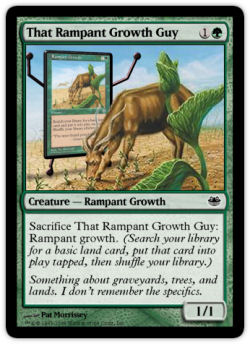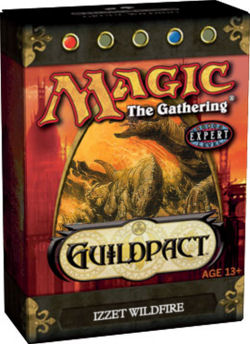I can’t seem to get rid of Mr. Knutson.
If anyone has good suggestions on how to stop him bothering me, I’m all ears. I figured once he moved on to bigger and better things — well, bigger anyway — my life could get back to the vacuum I am used to. But no sir, this man keeps plaguing me to submit articles for this site.
His last attempt is actually laughable. He didn’t want me to write an insightful article on the deeper nuances of the current Limited format… instead, his focus was on the deck that I, along with some teammates, played at Worlds this year in Yokohama.
Yes, I know. The man has obviously gone insane.
He wants an article on a dated Constructed Deck from a man noted for his lack of interest in the 60-card formats.
Or has he gone insane? Have I gone insane? Because you’re about to read that very article. Assuming, of course, you don’t hit that “Back” button right now and go do something more useful.
Let’s start with the decklist. I’m not going to name this deck something stupid or try to name it after myself — I’m not even sure if I want to be associated with it. I’ll just call it U/R Wildfire.
Spells (34)

First of all, I would like to mention that we didn’t build this deck from scratch. My dear friend Simon Carlsson found a similar list right here on StarCityGames.com. I would also like to point out that this is the list I played at Worlds. In retrospect, the Sideboard is pretty bad. I will give suggestions on what to change below.
So, what does this deck try to do? I guess it is fairly obvious. You try to keep your opponent short on mana while replenishing your own hand with card-drawing spells. At the same time, you will be filling your graveyard with sorceries. Assuming the plan works, a lethal Magnivore will soon follow. Against a lot of decks you will not want to play the Magnivore until it actually kills them outright, but some decks can’t deal with a measly 8/8… if that’s the case, you might as well punish them for it.
So why didn’t this deck perform well at Worlds? Why is almost no one playing it and why have a lot of people not even seen it? I’ll list some reasons below:
1) It’s a land destruction deck. Land Destruction is usually terrible. Someone once said (I can’t remember who) during a time when Ponza was somewhat popular: “Ponza has no good matchups, except for the mirror when you win the dice roll.” This brings me to number two…
2) Dice rolls. The deck would be a serious contender if you came to a tournament with loaded dice.
3) It’s a Control deck without countermagic. If someone runs a maindeck Cranial Extraction at you, just pack it up. Games usually go long, and a lot of the time you find yourself playing an awkward game of control. Not the best feeling in the world to pass the turn and hope you aren’t dead before they pass it back to you.
4) Life from the Loam. No further comment necessary.

There are most likely more… just what is the name of that Rampant Growth creature? You get the picture. Which brings us back to the start of this article, why are you still reading? Well, much like being the ninth person to join a MTGO draft queue; it’s not all bad.
The deck has its good points:
1) It is pretty consistent. You will draw a lot of extra cards, meaning you will often find the answers you need.
2) Sometimes you just win. You will have games where your opponent does not play a spell before he has already essentially lost (just bring loaded dice and the patented lick-n-stick).
3) It’s a Land Destruction deck. People do get mana-screwed and even a slight screw will usually give you an easy win.
4) Your opponent will have dead cards. You don’t care about stuff like Pithing Needle, or random creature kill.
5) It does have good match-ups. We ran this deck in Yokohama since we figured Blue/Black control would be a massive part of the metagame. I won two out of three matches against this deck, only losing to Neil Reeves (who got pretty lucky). It is also pretty good against the beatdown strategies (everything from Boros and Selesnya to decks with an abundance of Elves and Birds).
To be fair, the pros have so far been outweighed by the cons. This is probably why almost no one is playing the deck. The age where good decks would take months to get discovered is long past. If this deck was fantastic, you would have heard about it. In fact, you’d probably be playing it.

When Ted brought up the idea that I write this article, I tried to find a good reason why I should. To me, there is really only one good reason — Guildpact. There just might be something that puts this deck over the top. I am sure there will be a good Blue/Red deck (R&D seems to like to pre-construct our decks for us). Even if it looks nothing like this one, there may be something to learn from it.
Oh yes, I should give some suggestions on changes to the deck. The maindeck is pretty solid, but the one Tidings could just as well be a Mountain or the third Counsel of the Soratami. If you are worried about maindeck Extractions, then you shouldn’t be playing this deck in the first place. The sideboard, however, needs work. Threads of Disloyalty are pretty bad; you are better off running Shock or something similar. You will need something like Keiga or Meloku to protect against boarded Extractions. The Icy Manipulators are solid against decks with Jitte, or creatures with Protection from Red (although no-one plays those).
Cards that we never had the time to try but that could be interesting are: Thoughts of Ruin, Blood Moon and Ebony Owl Netsuke. The Owl seems weak, but against Blue decks you often get into a Mexican standoff where they don’t have enough mana to play a threat without leaving themselves vulnerable. In those cases, the Owl would force the issue. Blood Moon is probably a good addition now that Urzalands are popular again, while Thoughts of Ruin might be good as extra Wildfires against Control decks.
The deck has another strong point that I have yet to discuss. It is actually fun to play. This is coming from someone who hasn’t enjoyed Constructed in a long time. If you like to draw extra cards (you know you do) and if you, like me, enjoy it more when you are drawing more card-drawing spells, then you will enjoy playing this deck. Of course it’s not like resolving Fact or Fiction… but you can’t have everything.
Bonus Section
I couldn’t bring myself to leave you without any advice on Ravnica Limited. Especially since I’ve been too lazy to write a single thing about it before. Thankfully, others have written articles on the subject (and most of them are pretty good). How to draft the different guilds, and how highly to rate different cards, has been covered, as well as most of the archetypes that break the guild barriers. The trick to succeeding in this format (and any other Limited format) is to master all these archetypes. If you ignore some of the options available to you then you might miss out on a much better deck. Below I’ll list (in no particular order) stuff that some of you might have missed.
1) Blue/Black is the best archetype. Ok, so you probably already knew that. It is interesting to note why this is true. Blue has too many good commons. It also has more good Uncommons than any other color, and anyone that has played Ravnica a lot will know that Uncommons is where the power is. Cards like Keening Banshee, or Mark of Eviction, or Ribbons of Night win you games. Blue also has the most cards that give card advantage.
2) This format is slow. Unless you are playing against Boros the games will take a while. Actually, unless you are playing against a lucky player wielding an aggressive Boros deck then the game will take a while. This makes card advantage even more important.
3) Boros is better off playing Ordruun Commandos than Sell-Sword Brutes. The hyper aggressive Boros deck has to be very lucky to win. Sure, it will win when it curves out nicely and doesn’t draw into too much land, but it has too many draws that can’t beat a reasonable draw from your opponent. If you have ever looked at a hand of four lands, Sell-Sword Brute, Viashino Fangtail and Rally the Righteous, you’ll know what I mean.
4) Starcitygames posted an article recently with the print-runs for Ravnica. My advice is to learn the important ones. Not counting off-guild alternatives, there are only four draftable decks. It is more important than previous formats to find out what the guy (probably not a girl) on your right is drafting. Print-runs can help you with this… just don’t screw it up. I’m not sure how the print-runs on MTGO correspond to real boosters. In the past there have been differences, especially with boosters from Europe.
5) Counterspells counter any spell. If your opponent tries to tell you that you aren’t allowed to Convolute his first pick then he is trying to cheat you. This one connects back to number one.
6) I am really hoping that people that read Star City know this already, but it is a sad fact that not everyone has figured it out. If your opponent has Vedalken Dismisser with Mark of Eviction going, while you have no pressure, then you should not be replaying that same creature every turn. You aren’t getting anywhere. It’s like watching Homer put his fingers into the electric outlet repeatedly (D’oh!).
Bonus Bonus Section
Cards that are probably undervalued (just the names, and if I’m wrong then I’m sure I will hear about it):
Strands of Undeath, Benevolent Ancestor , Caregiver, Ordruun Commando, Boros Garrison, Selesnya Sanctuary, Dimir Aqueduct, Golgari Rot Farm.
Ok, that’s all I can bring myself to write this time. My plan is to return with more articles once Guildpact is upon us, but with my history I find it better to not promise anything. I will also be spending a month in Hawaii leading up to the Pro Tour, and hopefully I will have more interesting things to do than write articles.
Until next time
